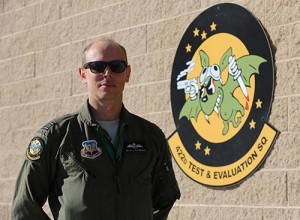2015-04-13 The US and British services operate often together and a key element of so doing is cross training.
In this piece published on the UK MoD website, the experience of an RAF pilot at Nellis at the 422nd squadron, which we visited earlier this year, is recounted.
Squadron Leader Nick deCandole joined the RAF in 1996 and after tours on Tornado F3, Jaguar and the first Typhoon squadron he joined 17(R) Test & Evaluation Squadron (TES), testing the latest developments on Typhoon.
When the opportunity arose to fly with the US Air Force he jumped at the chance: “In the beginning of 2011 it was obvious that this exchange, another TES post, was opening up and the timing was going to work out for me so I applied. I was lucky enough to be selected to come out to America to test the F-16 out here with the US Air Force.”
The 422nd TES at Nellis provides combat evaluation and operational testing of fighter aircraft and munitions in the USAF inventory including the F-16. Sqn Ldr de Candole:
“The USAF has a mandate to make sure all of their military hardware is not only meeting the contract it was sold against but also is suitable for the job. So we take something which has been tested by test pilots and then we fly it in an operationally representative manner and make sure that what the government intended to buy is what it’s got.”
“The test and evaluation I undertake here is very similar to the work I undertook on 17 TES. We test things which are post their safety check flying with test pilots and we’re testing them to see if they are good for deployment with the combat air forces.

I fly about the same as a UK front line pilot; approx. three times a week and about 150 hours a year. I fly the F-16 block 40 and 50 primarily in the suppression of enemy air Defence role because that’s the F-16s niche role. We also look at all the other roles the F-16 does like combat search and rescue, close air support and air-air.”
The single-engine F-16, which first flew in 1974, is one of the most successful modern jet fighters and is in service with many air arms across the world. Compared to the more modern twin-engine Typhoon, flying the F-16 is somewhat different as Sqn Ldr de Candole explained:
“Compared to Typhoon, when you climb into a F-16 cockpit it’s a little bit like a Jaguar, old dials for example which I wasn’t used to coming from Typhoon. You also sometimes have to trim it which is a real shock to me because Typhoon is a pleasure to fly and very easy. The F-16 also has nothing like the thrust of a Typhoon: takeoff on a hot day in Las Vegas without using afterburner is really quite a frightening experience whereas in a Typhoon that would be a complete non-event. In a Typhoon you could then climb with the nose pointing right up in the air to 30,000ft: that just doesn’t happen in an F-16; there’s no thrust there to do that.”
“However when you come to do the job, the F-16, having had 30 years of evolutionary development, it really quickly strikes you that pilots have been close to the design of the cockpit. So without taking my hands off the controls I can operate all the systems and change all the screens. This makes it a real pleasure to operate.”
Whilst the RAF does not operate the F-16, Sqn Ldr de Candole is of the firm view that his time in the USA is of benefit to the RAF: “Someone said to me that strategic alliances are not about codified treaties and so on, you actually fight alongside people you like and who you find it easy to fight alongside. The Americans like to work with us because they know how we operate and we are able to operate closely with them. The exchange program was set up in the seventies to facilitate that.”
“I will have contact with hundreds of F-16 pilots while I’m here and they will all remember flying with a British guy. Hopefully I’ll have left a good impression so on the next operation we’re involved in, hopefully they’ll be that much more willing to work jointly with us.”
Ongoing trials work on Typhoon is often conducted in the United States and being at Nellis is of great value as Sqn Ldr de Candole explained: “Over the last few years when I was on 17 Squadron we came out here five times in three years and did tests with the US Air Force test organization based at Nellis. This testing is ongoing and having me here now facilities that testing for 41 TES. As the man on the ground I understand the test objectives when they phone up, and how to fulfill those here in the range. It’s an invaluable post without which we’d get much lower-fidelity Typhoon tests.”

